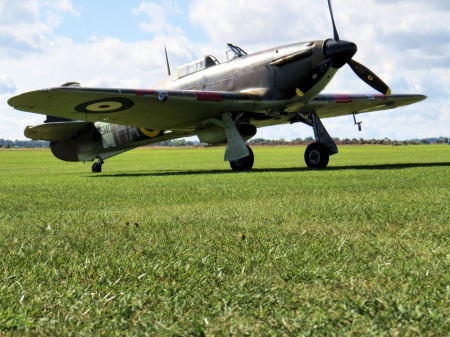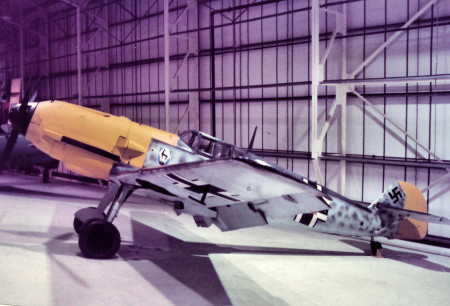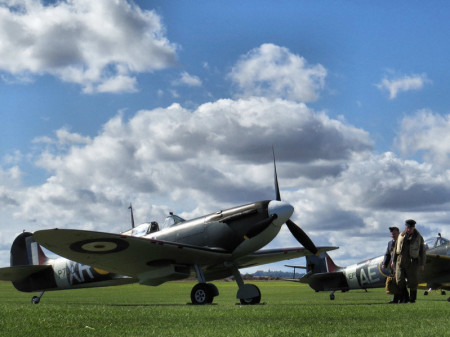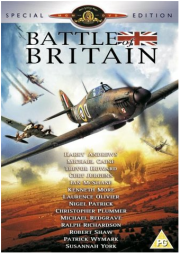
Hurricane and the Battle of Britain
In 1940, after Germany had successfully invaded France and forced what was left of the British forces to withdraw at Dunkirk, Hitler wanted to attack Russia. He knew that he had to get Britain out of the war first, either by negotiation or by invasion. Britain refused to negotiate however, so he and his generals drew up plans for the invasion of Britain.
The plans were code named Operation Sea Lion and it was decided that before the action could take place, air superiority needed to be gained over Britain to ensure the success of the German invasion. The code name for the Luftwaffe air campaign was called Adler Angriff or Eagle Attack.
The task of gaining the necessary air superiority naturally fell to the German air force, the Luftwaffe who were commanded by Reichsmarschall Herman Göering, Hitler’s most senior officer in his war cabinet. The result was the Battle of Britain which has been regarded as the world’s first pure air battle.
The three main fighter aircraft used in the Battle of Britain were the Hurricane and Spitfire on the British side and on the German side, the Messerschmitt Me109. This article highlights these three aircraft against the background of the desperate battle fought by the RAF, its pilots drawn from the British Commonwealth and other countries, the ground crew and staff and volunteers from other organisations to prevent the Germans from invading Britain.
Performance
There are many factors to be considered and the table shows key performance characteristics of the three main fighters. The best in a particular statistic is highlighted in gold.
|
Performance |
Hurricane I |
Spitfire II |
Me109e |
|
Max speed mph |
316 at 17,500ft |
354 at 17,550ft |
354 at 16,000ft |
|
Range miles |
460 |
405 |
412 |
|
Ceiling feet |
33,200 |
37,600 |
30,100 |
|
Rate of climb ft/min |
2,380 |
2,995 |
2,990 |
|
Power/mass hp/lb |
0·16 |
0·18 |
0·19 |
|
Armament |
8×0.303 machine guns |
8×0.303 machine guns |
2x7·9mm mgs 2x20mm cannon |
Hurricanes and Spitfires had an advantage in the secret supply of 100 octane fuel which substantially increased the performance of both aircraft types. Because of its lower top speed, the Hurricane tended to be sent up against Luftwaffe bombers while Spitfires would take on the Me109s. Top speed isn’t everything however, as dogfights generally began with one side having the benefit of surprise while the other would be at cruising speed.
Spitfire I
R6596 of 92 Squadron RAF, Biggin Hill, September 1940
The Spitfire and the Me109 were well matched in performance with the Hurricane some 14 mph slower top speed. Both British aircraft had better turning circles compared to the Me109. The float carburettor of the Merlin engines of the British planes would flood the engine with fuel in a dive and this could cause the aircraft to stall. The German aircraft didn’t suffer this problem because they had a fuel injection system in their engines which was a more efficient fuel delivery system. A common tactic if a Me109 was bounced by a British aircraft was to dive out of it knowing their pursuer couldn’t follow.
Beatrice ‘Tilly’ Shilling (8 Mar 1909-18 Nov 1990)
Born in Waterlooville, Hampshire, Beatrice Shilling was an aeronautical engineer. Her most significant achievement was to provide a solution to the problem of the Rolls-Royce Merlin engines of Hurricanes and Spitfires stalling in certain combat manoeuvres.
As soon as the device was proven to work she was tasked with leading a team of engineers to tour the country to modify Hurricanes and Spitfires with this device. Officially the device was known as the RAE Restrictor but was possibly cheekily yet certainly affectionately known as Miss Shilling’s orifice or the Tilly orifice by the RAF pilots that benefited from the device. Eventually Merlin engines were built with a better fuel management system.
She must have been a remarkable woman working in engineering in what was certainly a man’s world. Before the war she had raced motorbikes and after the war she, with her husband George Naylor (married 1938) raced cars such as the Sebring Sprite.
Firepower
On the face of it, Hurricanes and Spitfires were lacking in armament compared to the Me109s. The British aircraft were armed with eight Browning machine guns mounted in the wings firing .303in bullets. They had a maximum duration of continuous fire of about 16 seconds and they lacked cannon. Messerschmitt Me109s were armed with two 7·9mm machine guns and two 20mm cannon.
Bullets were basically small aerodynamic lumps of metal whereas cannon shells were much bigger and exploded on impact. The Me109s guns had a longer duration, about 55 seconds, but this may be because the machine guns were mounted on top of the engine and had to be synchronised with the propeller and the cannons had just 60 rounds per gun.
Endurance and Survivability
The self-sealing fuel tanks of the Luftwaffe aircraft were almost impenetrable to the RAF’s .303 machine guns and a good number of German aircraft returned safely to base riddled with bullets. The explosive shells of the cannon of the Me109 were devastating when on target but the low number of shells in each gun meant they had to get in close to the target. Spitfires, being all metal construction were more vulnerable to being hit by cannon shells. The rear fuselage of the Hurricane was made of wood and fabric so there was the chance that shells may pass through without exploding.
The Luftwaffe fighters had long journeys to and from their bases and could only afford maybe 10 minutes in combat over England. The British fighters were on home territory and this meant that they could remain in the combat area for longer and turn around on sorties more quickly.
In terms of replacing aircraft, the Hurricane took about 10,300 man hours to produce whereas 15,200 were required for the Spitfire. Either way British industry was more effective at replacing aircraft than the German industry. Contrary to popular belief there doesn’t seem to have been a shortage of replacement aircraft available to the RAF.
RAF organisation
The RAF had the benefit of having an extremely well-organised early warning system. A string of radar stations along the south coast detected the approaching bomber and fighter formations and thousands of Observer Corps aircraft spotters reported their numbers, types and direction. This information would ultimately go to 11 Group headquarters at RAF Uxbridge. From here fighter squadrons would be directed onto the attacking formations. German intelligence greatly underestimated this organisation and the effectiveness of the British radar system.
Strategy and Tactics
Being on the defensive, the RAF had the simple objective to prevent the enemy gaining superiority and prevent the enemy bombing targets. To this end an extensive and extremely effective warning and control system was set up.
As the battle progressed, commander in chief of the Luftwaffe Hermann Göring, under pressure from Hitler but without effective intelligence, switched tactics. He insisted that the fighters fly as escort to the bombers rather than fly independently to engage British fighters. This meant they had to cruise slowly with the bomber formations and were as vulnerable to surprise attack by the British fighters as the bombers.
Before the battle began, Hitler had directed that on no account should British cities be targeted. The Luftwaffe were only to attack factories and military targets. On 24 August however, during a raid on London’s docks, Luftwaffe bombers mistakenly dropped bombs in the centre of London. Churchill immediately ordered a retaliatory strike on Berlin for the following night.
Hitler was furious and rescinded his original directive and ordered that British cities be razed to the ground. This change of tactics from targeting British airfields allowed the RAF not only to recover, but also to build in strength.
Messerschmitt Bf109E
III/JG 26. Gruppenkommandeur (Group Commander) Major Adolf Galland’s aircraft late summer 1940 based at Caffiers, Pas de Calais.
The English Channel
Possibly the most important thing that influenced the outcome of the battle was not so much a particular aircraft nor was it a particular person. It was the English Channel. The previously successful campaigns of Blitzkrieg depended on the Luftwaffe and the Wehrmacht (German army) making coordinated advances on land. First the fighter aircraft of the Luftwaffe would secure air superiority, then the bombers would go in to break down the opposition, next the Wehrmacht advance into the territory and the Luftwaffe would move in to airfields captured or created behind the line.
In this way the Luftwaffe bases are advancing keeping the range of their offensive missions to a minimum. The channel made this impossible and the Luftwaffe were fighting alone with no opportunity to advance. Waging an air campaign from the continent fighting at long range, Luftwaffe pilots, especially fighter pilots, had to keep their eyes on their fuel gauges. Often the fighters might have only enough fuel for 10 minutes or so in combat. The RAF pilots were on their own territory and could fly several sorties a day making each aircraft and pilot more effective in the battle.
Spitfire or Hurricane?
There is no doubt that the Spitfire was the better fighter aircraft in terms of performance. Luftwaffe fighter ace Adolf Galland held the Spitfire with high regard and at one point during the battle said: ‘The Bf 109 was superior in the attack and not so suitable for purely defensive purposes as the Spitfire, which, although a little slower, was much more manoeuvrable.’
Galland should know what he was talking about. During the Second World War he flew 705 sorties encountering both Hurricanes and Spitfires. Of his wartime 104 aerial victories, 53 were Spitfires, 31 were Hurricanes the other 20 were mostly bombers. He was shot down 4 times during the war, at least twice by Spitfires. Later in the battle, Reichsmarschall Göring held a briefing of senior officers and asked what his pilots needed to win. Galland replied: ‘I should like an outfit of Spitfires for my squadron.’
The Hurricane was credited with shooting down about 60% of enemy aircraft during the battle. Not only more than the Spitfire but also more than all other aircraft types and other forms of defence put together. To be fair it was the most numerous RAF fighter deployed in the battle so could be expected to have a high tally.
A better question might be could either aircraft type have won the battle without the other and my personal view is it would have been more difficult. Hurricane numbers by the end of the battle were down by about 12% with Spitfires down by about 6% which is not far apart. It took about two-thirds of the time to replace a Hurricane than it did a Spitfire and it was often easier to repair a damaged Hurricane. Both aircraft had their good points and their frailties and again in my view both aircraft were needed to ensure victory. In the Battle of Britain quality and quantity were both important factors.
The outcome
The military statistics for the Battle of Britain show an overall victory for the British. 2,550 German aircraft were destroyed compared to 1,960 on the Allied side. About 2,700 German airmen lost their lives against 544 British and her allies. There were some 40,000 civilian fatalities during the battle. It was the first big victory for the British in the Second World War and, in spite of the casualties, it was a huge boost for morale.
Other German aircraft involved in the Battle of Britain
Messerschmitt Me Bf110C-4
2/NJG 1, 1940
The twin-engined Me110 had a higher top speed than the Hurricane but it lacked the manoeuvrability of the single-engined fighters and was soon withdrawn from the Battle of Britain. It was later effective as a defensive night fighter. The aircraft depicted above flew with a night-fighter squadron in defence of German-occupied Europe during 1940.
Performance Me 110C
Powerplant 2 x Daimler-Benz 601 1,085 hp V12
Maximum speed 348 mph
Range 2,410 miles
Ceiling 35,000 ft
Armament consisted of 4 x 7·92mm MG 17 forward-firing and 1 x 7·92mm MG 15 in rear cockpit.
The Heinkel He111 is probably the most recognisable bomber ever produced. Even if you are not familiar with its designation, you will know it as the quintessential German bomber of World War Two and the Battle of Britain in particular.
Performance He 111
Powerplant 2 x Junkers Jumo 211F 1,340 hp each V-12
Maximum speed 273 mph
Range 2,300 miles
Ceiling 21,330 ft
The Heinkel 111’s crew of 5 consisted of pilot; navigator/bombardier/nose gunner; ventral gunner; side gunner; radio operator/dorsal gunner. Armament consisted of 4 x 7·92mm MG 17 machine guns. Up to 4,400 lb of bombs carried in internal bomb bay.
Other Luftwaffe medium bomber types included the Dornier Do17 and the Junkers 88. None of the three main bomber types had a tail gun position.
Junkers Ju 87B1 ‘Stuka’
1(St)/TrGr 189, France, May 1940
The Junkers 87 ’Stuka’ was a very potent weapon in the Spanish Civil War and in the Blitzkriegs of the early stages of the Second World War. With their wailing sirens they struck terror against the poorly-equipped oppositions of these campaigns.
On 4th July 1940, ‘Stukas’ attacked a convoy in the English Channel, sinking four and damaging six others. Apart from this action and a few other skirmishes early on, ‘Stukas’ were largely ineffective during the Battle of Britain. Against the more organised opposition they proved to be slow and easy to detect and intercept. They were soon withdrawn from this area of conflict.
Performance Ju 87B
Powerplant 1 x Junkers Jumo 211D 1,184 hp V12
Maximum speed 242 mph at 13,400 ft
Never exceed 373 mph
Range 311 miles
Ceiling 27,000 ft with 1,100 lb load
Armament consisted of 2 x 7·92mm MG 17 forward-firing and 1 x 7·92mm MG 15 in rear cockpit. 1 x 550 lb bomb under fuselage and 4 x 110 lb bombs under each wing.
Other British fighter aircraft involved in the Battle of Britain
Boulton Paul Defiant I
L7013 PS-A of No.264 Squadron, August 1940
The Boulton Paul Defiant was a turret fighter with no forward firing armament intended to fly among enemy bombers and destroy them from within the formations. Whilst the aircraft was reasonably successful in this role, the weight of the gunner and the turret along with the drag created by the turret made the fighter slow and vulnerable to the conventional Me109 fighters of the Luftwaffe.
The tactic employed by the Defiants to escape attack from the Me109s was to form a Lufbery Circle where they would follow each other in a horizontal, gradually descending circle. In this way each aircraft would defend the others in the circle and makes the Luftwaffe pilot’s task of attacking an individual aircraft them very difficult as it exposes them to return fire from the other Defiants in the formation. The circle gradually descends in order to try to prevent attack from below.
The Defiant was withdrawn from the day battle and more effectively used as a night fighter until it was succeeded by the Beaufighter and Mosquito. Later it was useful in gunnery training, target towing, electronic countermeasures and air-sea rescue.
Performance Defiant
Powerplant 1 x Rolls-Royce Merlin III 1,030hp V12
Maximum speed 304 mph at 17,000 ft
Range 465 miles
Ceiling 31,000 ft
Armament consisted of 4 x 0·303 in Browning machine guns in hydraulically powered dorsal turret.
The twin-engined Bristol Blenheim IF fighter versions were perceived as a long range fighter but proved to be too slow and, due to high losses on daylight operations, the role was soon switched to night fighters. A squadron of obsolete Gloster Gladiator biplane fighters was stationed in Devon but took no significant part in the battle. Two squadrons of Fleet Air Arm Sea Gladiators, Nos 804 NAS and 808 NAS, were assigned to fighter command but also to no particular effect.
Battle of Britain 1969 movie
This is film based on factual events is one of the most significant war movies ever made. It is notable for its spectacular aerial battle sequences. Whilst much of the sub-plots are probably fiction the film depicts the events with as much accuracy as possible.
100 aircraft were used including 6 Hurricanes, 3 of which were airworthy. The Messerschmitt Me 109s were supplied by the Spanish air force and ironically were powered by British Rolls-Royce Merlin engines. The total fleet including the German aircraft was said to be the 35th largest ‘air force’ in the world at that time. A B25 Mitchell was used as the main camera platform along with two two-seat trainer Spitfires. This is a remarkable movie and a must for any collection.
Hawker Hurricane I replica
L1679 JX-C was built for the film The Battle of Britain. I was told that it had been fitted with a Rover V8 engine so that it could be used for taxiing shots. It is on display at the Tangmere Military Aviation Museum, West Sussex.
Cast for The Battle of Britain included: Laurence Olivier (Air chief Marshal Sir Hugh Dowding), Trevor Howard (Air-Vice Marshal Sir Keith Park) and Patrick Wymark (Air Vice-Marshal Trafford Leigh-Mallory). Other cast in alphabetical order: Harry Andrews, Michael Caine, Edward Fox, Ian McShane, Kenneth More, Christopher Plummer, Ralph Richardson, Robert Shaw, and Susannah York. The German cast were almost all German actors and their dialogue was subtitled. It inevitably had to include Curt Jürgens.
Director: Guy Hamilton
Producers: Harry Saltzman and S Benjamin Fisz
Script: James Kennaway and Wilfrid Greatorex
Musical score: Ron Goodwin
Chief advisors: Adolf Galland and Robert Stanford Tuck
My name is Gary Flint. I'm author, photographer & illustrator for Postcards from Slough. If you wish to make any comments on the contents of the website please click on the ladybird below:
Gary Flint
08/03/1961 - 09/04/2019
Postcards from Slough is an independently funded website. We are open to offers of sponsorship from companies that have any connections to the town. To contact us please click on the ladybird below:
Chalvey Community Forum
Postcards from Slough is linked with a local action group the Chalvey Community Forum. The group liaises with various local organisations in order to improve the quality of life for residents in the ward of Chalvey and Salt Hill. To learn more please click on the maidenhair leaf below:
Museum of Berkshire Aviation
I volunteer as a guide at the Museum of Berkshire Aviation. It is a special museum and if you would like to know more about the museum then please click on the motif below:
To learn more about the museums activities while staying within this website click on the tab at the top of the page or on the motif below:
Graces Guide
Postcards from Slough uses some images from Grace's Guide. Click on the button below:
British Listed Buildings
Postcards from Slough contributes material to British Listed Buildings and uses the site for cross referencing purposes. Click on the button below:












